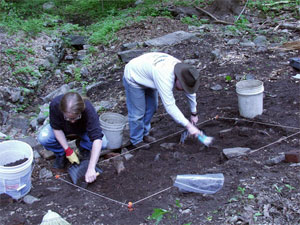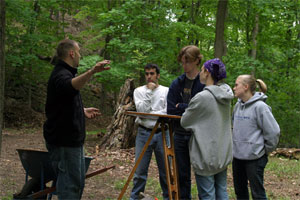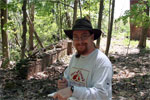Click on photographs to enlarge

Pat and Graham begin excavations at the furnace during week 2.

Five by five meter grid marked by pin flags over part of the East Bank House area.

Crew member Dan (center) & Evan, Janelle, & Caitlin (far right) listen to Mike (far left) talk about the plan for excavating one morning.
All photographs taken by field school students and staff
|
Weekly updates from the 2005 Field Season
Select a week hotlink below
Week 2 of the 2005 Field Season
By Graham Sheckels
I am Graham Sheckels, a native of Detroit, Michigan. I came to this field school on the recommendation of a Professor of mine, Mark Cassel, and an alumna of the field school, Vanessa McLean. My own background lies in iron and steel processing, as I did my Bachelor's and Master's work in Materials Science and Engineering. Lately, I have begun studying Archaeology with an interest in archaeometallurgy, which is the study of past metallurgical manufacturing techniques.
Thus, the opportunity to help excavate what was once a premier center of iron production has been intensely exciting. While there are very few structures which are still standing, it is immediately apparent to any visitor that this was a dynamic and extensive industrial operation in its heyday.
I have been quite impressed with the West Point Foundry site – there are certainly many areas which have ripe potential for investigation. This season, Arron Kotlensky and Michael Deegan are excavating two of the most interesting parts of the Foundry. Arron is interested in the Blast Furnace area, and especially how the furnace may have interacted with the Casting Shed in the casting of iron pigs. In the Furnace, foundry workers heated a combination of iron ore and flux to extract iron. There is also some evidence that a channel may have carried water under the furnace, which would be unusual in the design of blast furnaces from its time period, and is of interest. Meanwhile, Michael is looking at what is known as the East Bank House. At this time, it is unknown who may have lived in this house and what association it had with the Foundry. Hopefully, Mike’s work will be able to shed light on the history of this structure and its immediate environs.
This past week, work at both the Blast Furnace and the East Bank House has proceeded well. In each case, the early part of the week was spent mapping the sites and preparing them for excavation. An area must be mapped before excavation, so that we can tell how it looked before we began digging. At the East Bank House, an extensive 5 meter by 5 meter grid has been laid down, and the location of the foundation and other features of interest have been mapped via electronic surveying equipment. This effort shall allow a detailed study of the house and its immediate environs to be undertaken. At the Blast Furnace, the precise locations of all the features of interest, such as the retaining wall, the slope of the charging deck, the remaining parts of the furnace, and the nearby slag heap were also precisely mapped, again via electronic surveying equipment.
The later part of the week, each team began digging at the site in earnest. At the East Bank House, shovel test pits are being dug in each of the 5 by 5 meter grid sections, with the aim of looking at the concentration of artifacts and at the variation in stratigraphy over the entire area. At the Blast Furnace, the particular site I have been working on, we have opened up two excavation units. My excavation unit will hopefully reveal the relationship between the furnace itself and a near-by retaining wall, and will perhaps catch the edge of the casting shed thought to have been south of the furnace. The other excavation aims to study the southern remains of the furnace including its casting arch and perhaps part of the casting shed. As both of these units are located on a slope, and have so far contained a significant amount of rubble, excavation has gone slowly but steadily.
For the next week, excavation is planned to continue at both sites. At the East Bank House, they plan to continue digging shovel test pits, and will start to work in our laboratory to clean the artifacts that they have recovered so far. In the area of the Blast Furnace, we have begun to define a layer of rubble that has been laid down over time. We will carry on moving downwards, through the rubble to determine what is underneath. This may also give insight on to how the rubble came to be deposited – whether it all fell in one catastrophic episode or through the gradual decay of the structures over time. Additionally, at the Furnace we plan to take samples from the slag heap south of the furnace. Visit us again next week for another update and to hear how the excavations are proceeding.

Graham Sheckels, the author, busy recording archaeological data.
|



